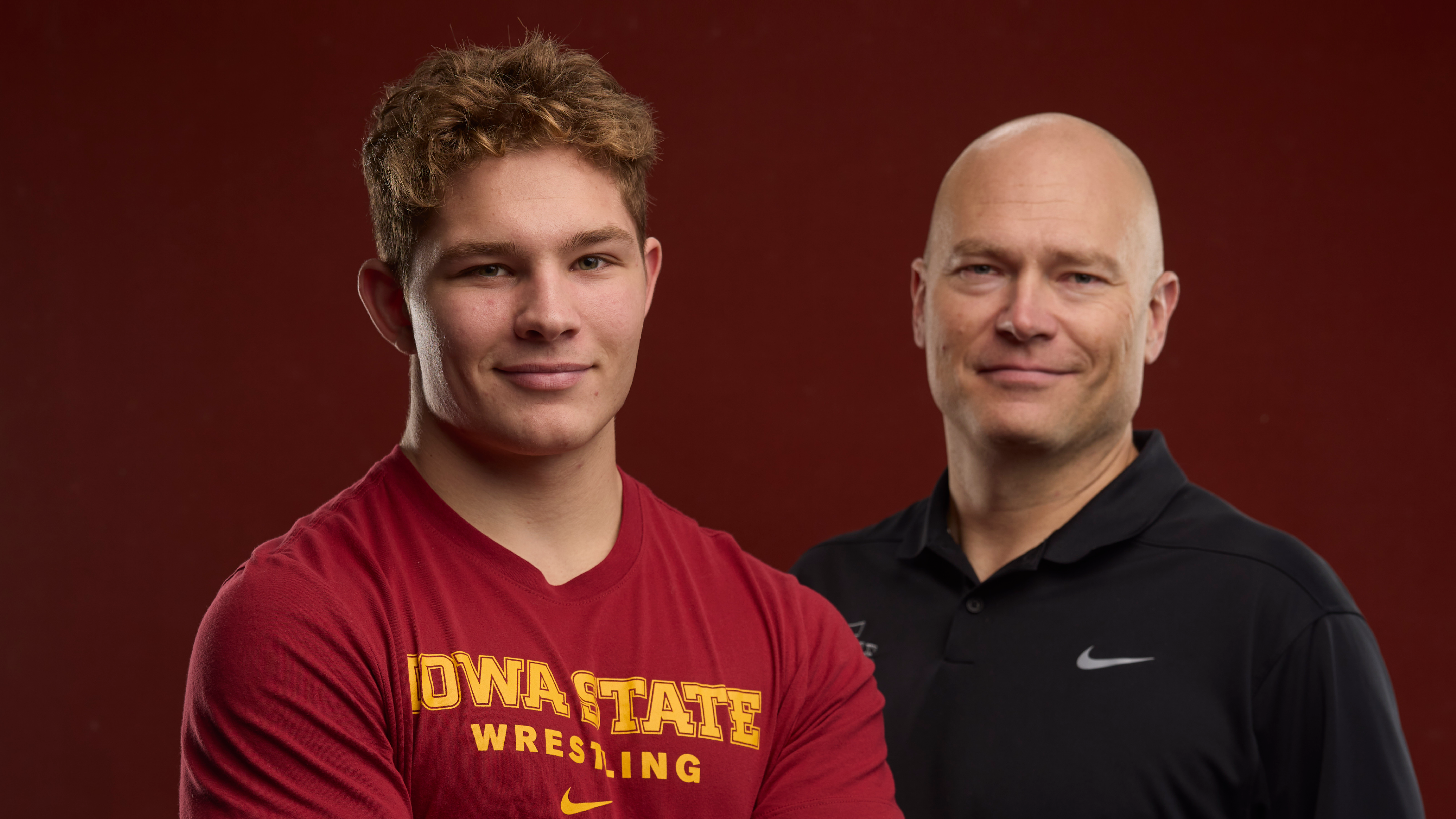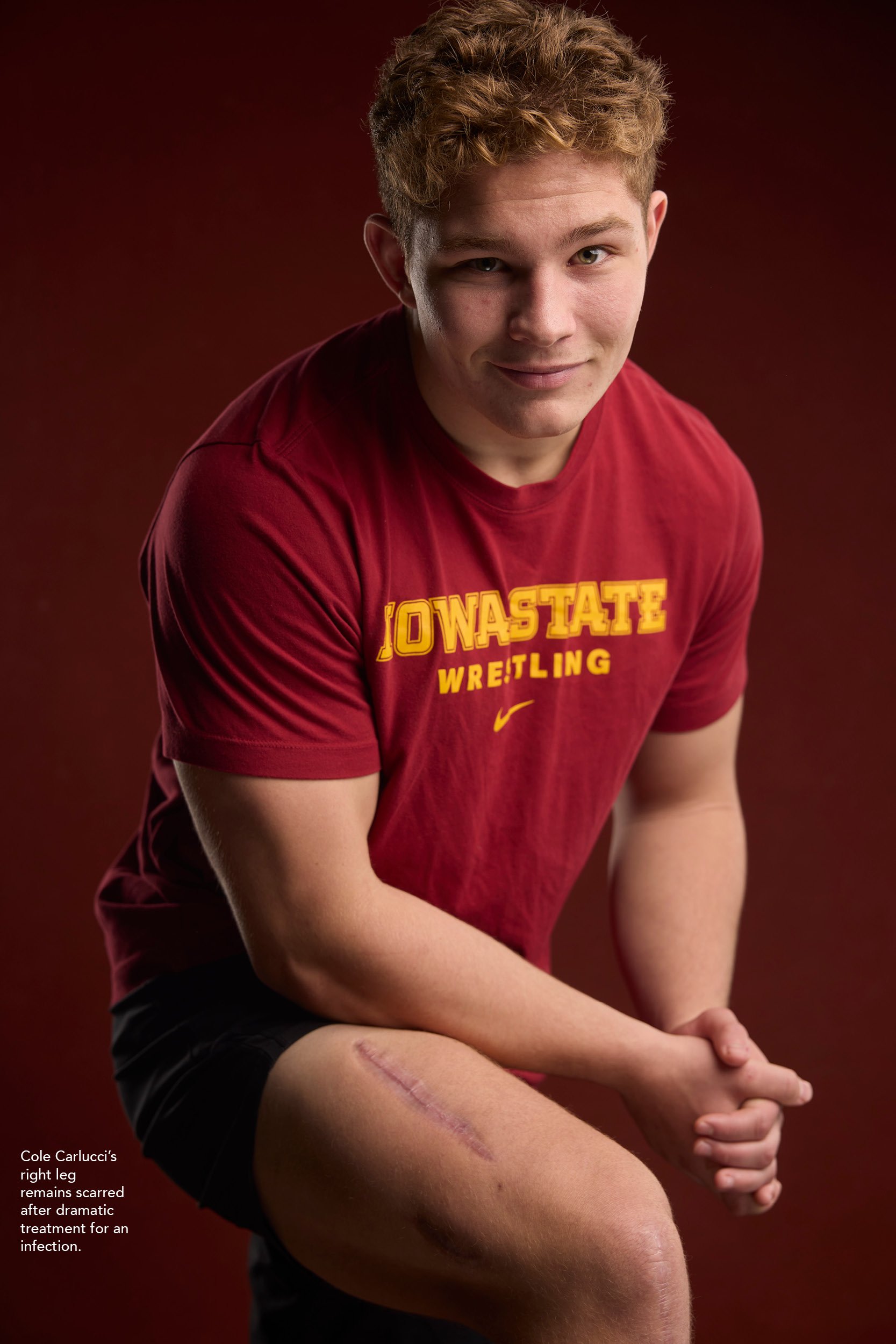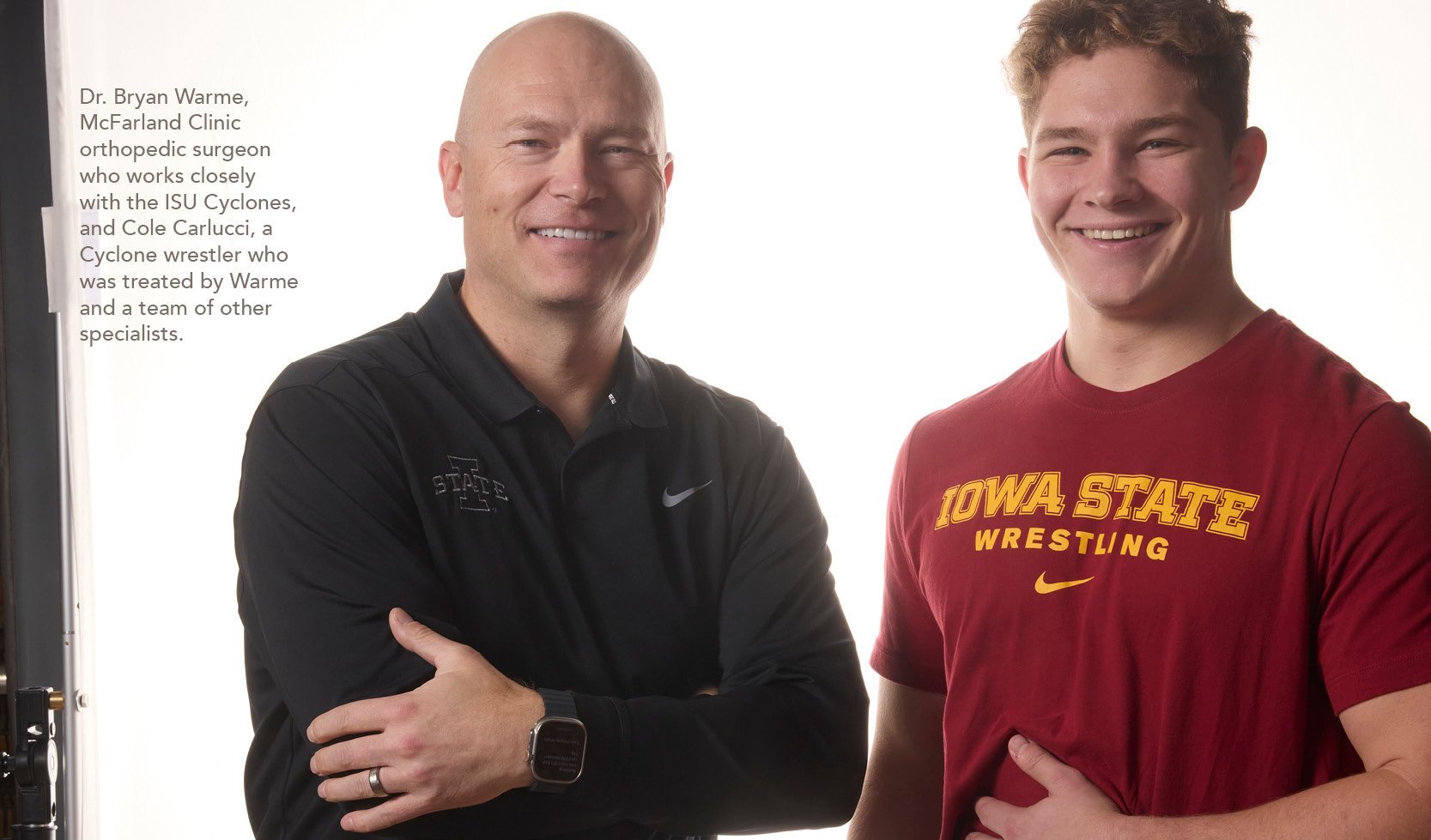Muscling Through | Cole's Story
How a team of specialists came together at Mary Greeley to save a young student from a life-threatening infection.

If Cole Carlucci is wearing shorts, someone will inevitably ask him about his scars.
There are four on his right leg and you can’t miss them.

“I kind of like when people ask me about it. I'll just tell them I got a crazy infection. Pretty rare, though, so you don't have to worry about it,” he said.
‘Crazy’ doesn’t quite capture the level of health crisis Cole faced. ‘Potentially life-threatening’ does though.
Cole’s Team
Cole knows what it means to be part of a team. He played football in high school and is an Iowa State University Cyclone wrestler. However, the most important team he joined may be the one that fought a formidable opponent: a potentially deadly infection invading Cole’s body.
“This was a really challenging case,” said Dr. Bryan Warme, a McFarland Clinic orthopedic surgeon who operated on Cole. “From a treatment and diagnostic standpoint, it was complicated and challenging, and one that involved multiple specialties.”
“I love taking care of these hard cases, helping people through these tense situations,” said Dr. Dan Fulton, McFarland Clinic infectious disease specialist. “What I loved about Cole’s case is that we had all the specialists we needed from start to finish.”
Cole came to Iowa State from Colorado on a full-academic scholarship. He was hoping to play football in college, but that plan changed when he was invited to visit the campus by a representative of the wrestling program.
“I fell in love with Iowa State and Iowa,” he said. “I’m really happy I came here. I made the right decision for sure.”
While a high school senior, Cole had surgery on his ACL. He had to sit out part of his first wrestling season at Iowa State due to the injury. In April, he was eligible to compete at the U.S. Open Wrestling Match in Las Vegas but fell ill prior to the match.
"I noticed my leg was starting to hurt. They were both swelling. It seemed like nothing new because I had had a knee injury before,” he said.
He ended up at Mary Greeley’s Emergency Department with a 104 ° fever. After the fever was brought down, he was sent home with antibiotics. He was ultimately diagnosed with strep throat.
The next day, still feeling miserable, Cole’s trainer, Tim Weesner, sent him to the Stark Athletic Training Building. There, Cole met Warme, who works closely with the ISU Athletic Department.
“He and I went through a lot. It was a shared experience that brings people closer together,” said Warme.
Cole’s strep diagnosis may have been a red herring, Warme noted.
“It might have thrown the medical providers off. The strep throat could explain the high fever and why he was so sick. In reality, he had this infection brewing in his pre-patella knee area, which is in front of the knee cap. That’s what was making him really sick,” Warme said. “The strep throat, in retrospect, may have been just colonization of the bacteria and not an actual throat infection.”
"Dr. Warme saw me, and he immediately realized how serious it was,” Cole remembers. “He started talking about having to drain it, and even told me about possible surgery. I was shocked. I was like, ‘I just had a fever last night, and now I'm maybe getting surgery. I'm supposed to wrestle next week in the U.S. Open in Las Vegas.’”
Cole went back to the ER, and then was admitted to Mary Greeley for 14 days. On Sunday, April 16, he was in a Mary Greeley operating room having the first of several surgeries.

Facing the Opponent
During the first surgery, Warme opened up the area in front of Cole’s knee and washed out the toxic materials. Cultures were sent to Mary Greeley’s lab and showed that the fluid drawn from the knee had streptococcus, the bacteria that causes strep throat.
While having the diagnosis provided valuable information for antibiotic treatment, it was “concerning to me because this particular organism that causes strep throat is really dangerous when it's in soft tissues and, particularly, in areas that have what we call fascia, which is the body's material that envelops the muscle compartments,” said Warme.
This concern prompted Warme to get Cole back in the OR and wash out the infected area a second time.
“I thought this was going to be routine — wash it up a second time, close everything up, send him on his way,” Warme said. “When I got in there, the area that I'd washed out the two days before had spread into the quadriceps muscles underneath the skin.”
“Streptococcus bacteria produces destructive exotoxins. When it's in the throat, oxygen and other factors can neutralize the effects. When the toxins are trapped under the skin, it can be hard to get control of”, said Warme. A third surgery on April 21, revealed that the bacteria was moving further into Cole’s leg, prompting fears of necrotizing fasciitis, which is also referred to as “flesh-eating disease.” Shortly before Cole became ill, a college wrestler in Nebraska was diagnosed with this condition, intensifying concerns about the young Iowa State student.
“Necrotizing means that the tissue is dying. So, basically, it's a rapidly progressing problem where this fascia just dies and this bacteria spreads quickly,” said Warme. “I hadn’t really seen that since my residency, and I'm pushing 15 years into my practice now, and that was when we asked general surgery to start weighing in on this.”
Drs. Benjamin Schlicher and Gregory Sachs joined the team. The two McFarland general surgeons handle a greater volume of wound-related procedures compared to what an orthopedic surgeon typically performs. The two served as additional expert eyes in the operating room. An MRI was ordered to get a deeper look at the leg muscles.
“I remember Dr. Warme telling me, ‘Red is healthy, black is dead, yours is purple.’ Cole said. “He then told me, ‘I am going to go open up and look at your muscle. If it's dead, I have to take it out.’"
This was an unusually stressful experience for Warme, who is accustomed to getting injured young athletes back to their sport. With Cole, he was focused on saving the young man’s leg.
"As an orthopedic surgeon and one that focuses on sports medicine, I'm really wired mentally to fix things and get people back on the mat. In this case, it was the exact opposite,” he said. “This is where I was having to make decisions to cut out muscle and fascia in order to save the kid's leg, which is a destructive surgery, not the reparative surgery I’m accustomed to.”
"That was the part that was really hard – telling an otherwise really healthy kid who was an all-state football player, state champion wrestler, that this is a life-altering thing to radically take out dead muscle,” Warme said. “Thankfully, we decided not to take much at that point, and we were starting to turn the corner and win at that point.”
“It was extremely scary when you're about to be put to sleep, and you might wake up with no quad muscle,” Cole said. “So, going to sleep that day, I remember just praying. I was like, ‘I just want to be safe. I want to keep wrestling. I want to keep walking.’ I remember coming out of surgery and just feeling my leg, and just thanking God that it was all there.”
Cole still had open wounds on his leg, with pumps constantly removing potentially harmful fluid.
“By the fourth surgery, I had three giant pumps and sponges everywhere, and my leg literally looked like a cow with black spots,” he said. “I just laid in bed, and I heard those pumps ticking all day. It was crazy, but at least my leg was there.”
Antibiotics
“I’m just so thankful that Dr. Fulton had him on antibiotics, which were starting to kill the virus,” Warme said.
Cole didn’t technically have necrotizing fasciitis but “it was pretty darn close,” said Fulton.
A surgeon may opt to sacrifice a muscle in a person who may not use that muscle extensively. removal is done to speed up the intervention against the infection. With an athlete like Cole, the case gets complicated. Another obstacle he faced was the fact that the bacteria Cole carried had an unusual and unexpected resistance to antibiotics, which isn’t typical with streptococcus. This made treatment more difficult. Fulton worked closely with the surgeons on the case, monitoring the condition of the tissues in Cole’s leg to ensure the antibiotics were helping the team win this one.
“We all had it in our mind that this is part of who he is, and his quality of life really depended on him being able to keep his lifestyle,” said Fulton. “The challenge of strep infections is that they move so fast. By the time you know you have it, it’s already off to the races and you’re playing catch up.”
Oxygen Therapy
In the period between his third and fourth surgeries, Cole was referred to Mary Greeley’s Wound Clinic for hyperbaric oxygen (HBO) therapy, which was supervised by Dr. Sachs. The therapy involves a patient being placed in a hyperbaric chamber where they are treated with pure oxygen, which can help speed healing and regenerate damaged tissue. Cole and members of his team all felt that the therapy was worth trying and that ultimately, it helped.
“I’d never heard of it before, but I spent a lot of time in there. Six treatments, three hours, just watching movies. But people in the Wound Clinic were so nice,” he said.
"We really had to rely on the hyperbaric oxygen, the antibiotics, and the wisdom of other surgeons to look at things. Having both Dr. Sachs and Dr. Schlicher on board with this case was really helpful, because we're talking about catastrophic and very consequential decision-making for an 18-year-old kid. And to be able to have a consensus of the three of us on what we needed to do surgically was really helpful. And it brought peace to the family and to Cole to know that we were really thinking about this and coming to a commonality of what the right thing was to do,” Warme said.
Team Support
All through his ordeal, Cole had constant support. His parents arrived from Colorado. Iowa State helped him keep up with his courses, and the members of the wrestling program were a constant presence. His lifting coach even brought him light weights so he could get in some brief workouts while lying in his hospital bed.
His leg is all healed now and he’s back to wrestling. He even got in some waterskiing over the summer.
He looks back at his experience with grace and gratitude.
"I felt so cared for and protected, of course, by everyone from the hospital, all my nurses, doctors, but also the people from Iowa State Athletics, my faith community,” Cole said. “And Dr. Warme. I will feel forever grateful for him and how he protected me.”
On Saturday, Nov. 11, Cole wrestled at his first meet in 2 years. He won four of his five matches.
Grateful Parents
Cole Carlucci's mom and dad share their feelings about the care their son received.
Sending Cole Carlucci off to college in another state “was one of the hardest things we’ve done as parents, but we were confident that he was ready and we were so excited for him to start this new chapter of life,” said Cole’s mom, Elyse.
When Cole got seriously ill and had to have multiple surgeries, Elyse and Cole’s dad, Brian, soon learned that sending their son to Ames, Iowa, was a good decision. The young Cyclone had great support from Iowa State University, particularly the wrestling program, his faith community, and the medical team that helped him through his crisis. Cole’s parents are understandably grateful and were kind enough to share these thoughts with us:
“When you are far away from your kid it’s incredibly comforting knowing there are other people that will step in and care for them when you can’t. We are so thankful for the way Cole’s coaches, trainers and teammates supported our family. Cole’s trainer, Tim Weesner had waited with him for hours in the ER and in his hospital room. He came every day to sit with us and was an amazing go between for us and the doctors in understanding what we were up against and navigating each next step.
In addition to the support from the school and his team we appreciated the visits he had from leaders at his church and the college ministries he’s involved in.
We cannot speak highly enough about our experience at Mary Greeley. During a scary and unknown time, we felt so well cared for. Dr Warme and Dr Fulton went above and beyond to explain what they could so we could understand the seriousness of Cole’s sickness. Our nurses were caring and thoughtful.
Jamie (Warg) was our wound care nurse and was so knowledgeable, kind and patient. Doctors and nurses that made themselves available for Cole’s surgeries, after care and as sounding boards when trying to make critical decisions. The staff at Mary Greeley made us feel seen and heard. They took amazing care of all of us. One nurse from the wound care clinic that came in over the weekend to do the hyperbaric treatment on her day off told us “if this was my son, I would hope someone would do this for him.” That sums up how we saw Cole being cared for –doctors, nurses and everyone in between caring for him like he was their own.
It was a truly terrifying experience but we will forever be grateful for the Ames community, Iowa State and Mary Greeley for contributing to Cole’s full recovery and the bright future he has ahead of him.”